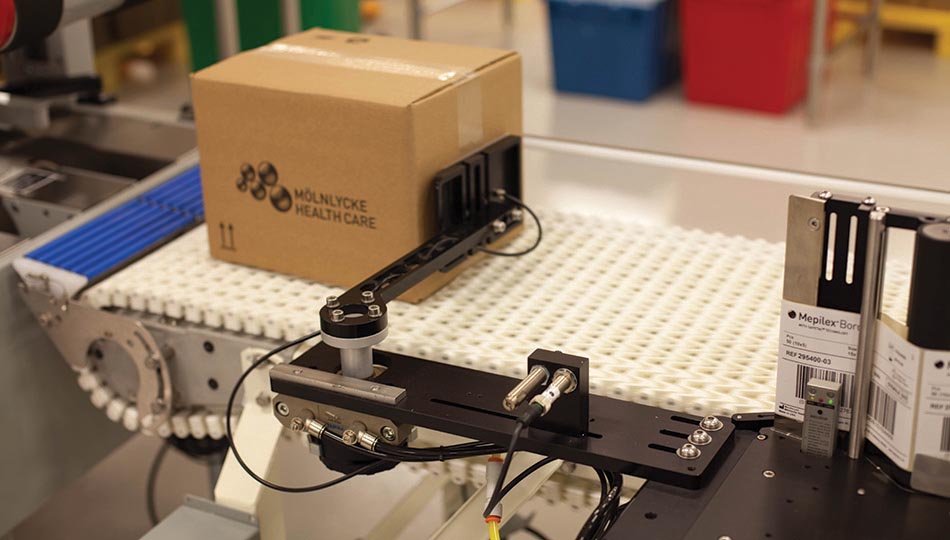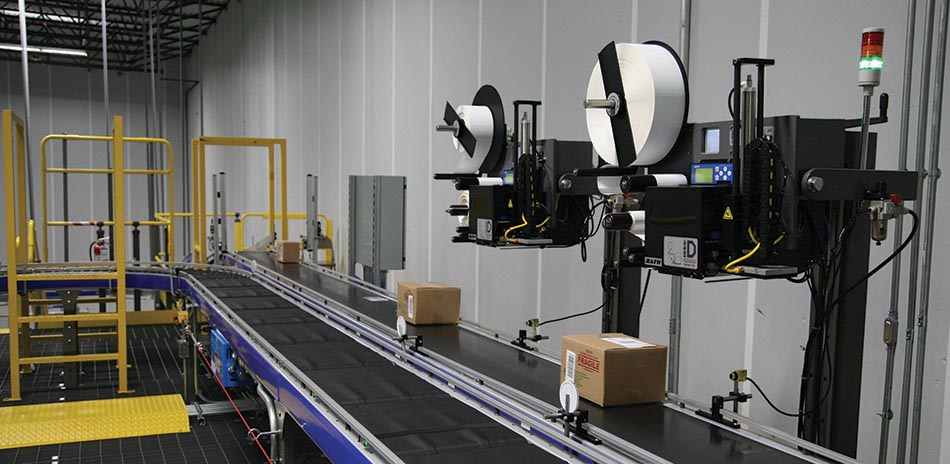How’s Your Mobile Data Device Maintenance?
Whether it’s a printer, tablet or scanner, maintenance downtime can bring your materials handling system to a complete halt. But so can equipment that is simply out of alignment. Traditional solutions to these challenges are being joined by advanced platforms that monitor performance and device condition.
Sometimes it’s just too easy to overlook scanners, printers, tablets and the like. The equipment is ruggedized and typically requires little attention. Maintenance is often an afterthought. But truly giving any of it too little attention can be costly.
“Printers and scanners are, in many ways, the most important part of any system,” says David Strawser, global support manager at Bastian Solutions. “They tell you where things are, where they’ve been and where they’re going. Those three details are critical to keep your operations running smoothly.”
That’s also true outside the four walls in field service operations. A survey released in March by Zebra Technologies says that between now and 2023, “handheld mobile computer usage with built-in bar code scanners is forecast to grow by 45%, mobile printers by 53% and rugged tablets by 54%.” Sounds like many are recognizing the importance of this equipment to field service operations.
The study goes on to say “higher levels of inventory, shipment and asset accuracy provided by using these devices is expected to increase business revenues.”
The story is much the same within the four walls. When was the last time you tired to run a warehouse without data? And, these days of building customer expectations and volumes is no time to try it.
So, that raises the question—how much maintenance attention is enough? The answer is actually wrapped up in the total cost of ownership, according to Videojet.
In a white paper, the company explains the answer to that question includes “the running costs of the equipment, the hidden costs of lost production due to unscheduled downtime, and decreased efficiency caused by repeated ‘touches’ often necessary to operate the system.”
In other words, maintenance takes on new meaning here. Several suppliers agree that ensuring the equipment is running optimally all the time is just as important as avoiding equipment downtime due to maintenance issues.
As Strawser points out, “a scanner is only as smart as it is programmed to scan or a printer as it is setup to print.” For a mobile device, a dead battery is a defining moment. He also points out that introducing a new label design without telling anyone can bring a system to its knees without proper recalibration of scanning equipment.
Following are some best practices for taking a big picture view of maintenance of automatic identification and data capture equipment.
Start with training
“This is precision equipment, but it isn’t always treated that way,” explains Craig Bailey, director of Cubiscan’s integration services.
To help bridge that gap, keeping equipment up and running with precision starts with training. As Rick Fox, CEO of Fox IV, explains, people out on the floor need to be tuned into key aspects from proper setup to long-term runtime. Do it right, and there’s no reason why you can’t expect printers to last more than 20 years as is the case at the Cleveland Plain Dealer, says Fox.
Fox IV, for instance, offers several different training programs with various levels of detail. They can range from a two-hour session to a two-day session. But regardless of the length, the key components are much the same.

Printheads are durable for two to three million linear inches of label printing.
For label printer applicators, operators need to know how to load labels and ribbon and properly power-up the unit. They provide tips on making adjustments to setup and diagnostic menus. Cleaning procedures and troubleshooting are also part of the training.
As Fox explains, printheads are durable, able to print two to three million linear inches of labels before replacement. But, they do require some attention along the way.
Warehouses are dusty environments especially with all the corrugated that passes through. That requires regular printhead cleaning with the replacement of every label roll or every shift. Similarly, media and ribbon sensors, brake pads and applicator pad surfaces should be cleaned weekly. Several other components from label cutters to print engine belts need quarterly attention.
Something as seemingly simple as label stock can be an issue, too. “On the preventative side of maintenance, you want to have the right stock available at all times,” explains Strawser. “Change the stock, and it has an impact from possible jamming to poor feeding or improper application. Unfortunately, different purchasing departments have different practices and can cause problems by substituting stock for purchasing not operational reasons,” he adds.
As to scanners, it’s rare that the internal scanner goes bad, says Strawser. However, problems can arise in day-to-day operation. For instance, the laser beam output window needs to be clean. And since the scanner might get bumped, says Bailey, it is good to check that the scan line is correctly positioned, the scanner focused, and the reading distance within norms. Vibration can also cause an issue.
Bailey explains that troubles with scanners might not even start with the scanner itself. Instead, retro-reflective photo eyes on the conveyor line might be misaligned. In turn, this affects when the scan occurs and can be highly disruptive if out of whack.
Just as the wrong stock can cause printer problems, poorly printed labels can cause scanner issues, says Bailey. These issues range from speckled or light printing to insufficient quiet zone for the scanner to calibrate correctly.
The upshot of all this is the equipment might be rugged but the actual operation of it and all components can be hampered by something as simple as dust or a bump in the night. As Fox points out, keeping it all up and running is not to be taken lightly.
“Good maintenance starts with solid training but continues with day-to-day maintenance of the operating environment. That traditionally requires people power. But unfortunately, people who are good at that generally get promoted, leaving a gap until a new person is trained and proficient,” says Fox. That is, if you can get a person in the first place.
Monitoring it all
Fortunately, traditional device maintenance programs are morphing into asset/device management programs. We are in the early stages here, but the move is clearly to more automated monitoring of operations and equipment condition, minimizing the traditional role of people.

Poorly printed labels can cause scanner issues, often limiting package throughput.
Help desks and contract maintenance programs have long been in place, explains Taylor Smith, chief marketing officer for Honeywell’s Productivity Products. And, they continue to be a viable path.
Smith explains that Cloud-based solutions are starting to take their place in the new maintenance and performance equation for fixed and mobile data capture and management devices across the enterprise.
And he is not alone in that view. Zebra is on a similar path, says Mark Wheeler, director of supply chain solutions. “For maintenance to be effective, there are three steps. First, the device has to communicate with the enterprise. Second, the status of the device must be available. And third, there has to be communication that any maintenance is correctly done on the right asset,” says Wheeler.
Communication is the byword for a real-time virtual access system from Panther Industries, explains David Starck, marketing manager. Introduced at ProMat 2019 in April, Panther Analytics monitors two lines of the company’s print-and-apply systems. “It monitors not just the equipment performance but the service response times of people to various issues,” says Starck. He says the system is unique among print-apply systems.
A standard Panther Industries system monitors 20 base line performance indicators. Panther Analytics provides access to an additional 100 data points. The data can be reviewed in real time within the company’s internal network on a variety of devices and operating systems.
Both the Zebra and Honeywell monitoring systems manage a much broader range of devices from printers to scanners and mobile devices such as tablets.
For instance, Honeywell Operational Intelligence is a Cloud-based software solution that tracks, manages and optimizes mobile computers across all of a company’s locations. This asset management solution is software and hardware agnostic, supporting Android and iOS operating systems as well as those from any supplier, including Honeywell.
The idea, says Smith, is to track mobile assets, manage their lifecycles, standardize processes and optimize business results. It monitors usage and utilization as well as software updates, an aspect of maintenance often overlooked. These and other data points are transmitted back to Honeywell as encrypted data that the supplier analyzes and makes recommendations for resolution of issues.
“Operational Intelligence provides excellent visibility of equipment operation and its condition without requiring equipment to be returned to us,” says Smith. He adds that 30% of devices returned to Honeywell did not have to be, incurring unnecessary costs and downtime.

Handheld mobile computers with built-in scanners are projected to grow 45% between now and 2023.
Over at Zebra, the emphasis is also on device management including tracking the location of all devices, explains Wheeler. The company’s Remote Management System aims to reduce the total cost of ownership of scanners and printers. It configures scanners, loads parameters, updates firmware and queries asset data. In the case of printers, it tracks media and error status in real time.
Wheeler says Zebra has also developed a location engine that provides real-time location of all devices using a passive radio frequency tag. It is an important component of a maintenance program by identifying asset locations so they can be used most effectively given their conditions.
Clearly, maintenance of data devices is entering new territory. The future is all about more automated monitoring of operations and equipment condition for maximum utilization and minimal total cost of ownership.
Companies mentioned in this article:

Article Topics
MRO News & Resources
Avidbots showcases autonomous cleaning robots Traka exhibits modular lockers MRO Survey: Finding and keeping the best technicians Maintenance, Repair and Operations: Understanding the true condition of the equipment Newly formed Bison combines AMETEK DFS and Bison Gear and Engineering Corp. Building (and maintaining) your maintenance, repair and operations (MRO) tech workforce The power side of lift truck battery and charger maintenance More MROLatest in Materials Handling
Beckhoff USA opens new office in Austin, Texas Manhattan Associates selects TeamViewer as partner for warehouse vision picking ASME Foundation wins grant for technical workforce development The (Not So) Secret Weapons: How Key Cabinets and Asset Management Lockers Are Changing Supply Chain Operations MODEX C-Suite Interview with Harold Vanasse: The perfect blend of automation and sustainability Consultant and industry leader John M. Hill passes on at age 86 Registration open for Pack Expo International 2024 More Materials HandlingSubscribe to Materials Handling Magazine

Find out what the world's most innovative companies are doing to improve productivity in their plants and distribution centers.
Start your FREE subscription today.
April 2024 Modern Materials Handling

Latest Resources












